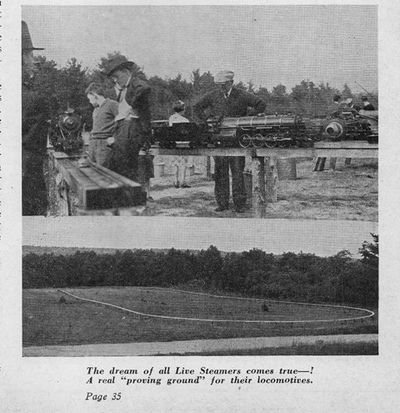BLS Summer Meet 1936: Difference between revisions
No edit summary |
No edit summary |
||
| Line 3: | Line 3: | ||
by G. A. Olmstead, <i>Model Craftsman</i>, August 1936 | by G. A. Olmstead, <i>Model Craftsman</i>, August 1936 | ||
Courtesy of [http://www.chaski.org/homemachinist/viewtopic.php?f=8&t=98267 Steve Bratina, <i>Chaski.org</i>] | |||
<i>The live-steamers hold their summer meet up in Maine. A neophyte writes in wondering how to change tinplate to live steam and this department editor ends up with about five hundred pounds pressure and no safety valve.</i> | <i>The live-steamers hold their summer meet up in Maine. A neophyte writes in wondering how to change tinplate to live steam and this department editor ends up with about five hundred pounds pressure and no safety valve.</i> | ||
Revision as of 23:56, 26 January 2014
BLS Summer Meet 1936
by G. A. Olmstead, Model Craftsman, August 1936
Courtesy of Steve Bratina, Chaski.org
The live-steamers hold their summer meet up in Maine. A neophyte writes in wondering how to change tinplate to live steam and this department editor ends up with about five hundred pounds pressure and no safety valve.
On the 7th day of June (1936) the Brotherhood of Live Steamers held their Summer meet at Oxford, Maine. This event was of more than ordinary importance to the owners of the engines, as the track is one which tests the capabilities of even the best locomotives.
The two gauges, 2-1/2 inch and 3-1/2 inch, are laid in the shape of an ellipse, about 1,000 feet in circumference. There are up grades and down grades, curves and tangents, so that the engine which holds both its speed and steam pressure must not only be well built and of excellent design, but it must also be handled by a man who understands the art of making steam and keeping up his water level.
To the man in charge of a free steaming engine, a run on this track means unalloyed pleasure. The long pulls up grade, when the exhaust is clear and loud and the fire becomes white, give him a feeling of exhilaration which can never be obtained from short runs on level track. The sensation of power which comes from always having a little more steam than the engine uses,--the hurried firing while drifting down grade--watching the water level and handling the throttle to the best advantage, these are the pleasures which can only be had on a track of sufficient length to permit performances comparable to those of full size locomotives.
The Brotherhood of Live Steamers is composed of those who build or have built live steam models. This necessarily limits their membership, in fact, they are the elect among model-makers, along with the men who build three foot boats which travel twenty times their length in a second, though this is not meant to disparage those who build accurate, scale, non-working models. The Live Steamers must be more than good machinists, capable draftsmen and practical engineers. They must have patience, ambition and experience, qualities which make a visit to one of their meets an event to be remembered with pleasure and looked forward to with an anticipation of meeting again one of the finest groups which it has been the writer's privilege to know. The next meeting will be at Marblehead in September. I shall have the date in time for the next issue.
The track at Oxford was built by the Lake Thompson Fish and Game Association. Being sportsmen, they seem to have decided that a sporting track was needed, so they provided stiff enough grades to test the hauling capacity of any locomotive and the handling skill of experienced engineers. If there are any weak points in either the design of the engine or the technique of the engineer, they will eventually be shown up. When a successful run is completed, there can be no doubt as to the capabilities of either man or machine.
